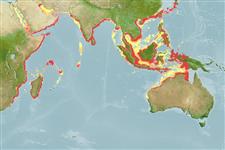Common names from other countries
Classification / Names / Names
Nomi Comuni | Sinonimi | Catalog of Fishes (gen., sp.) | ITIS | CoL | WoRMS
Environment: milieu / climate zone / depth range / distribution range
Ecologia
Benthopelagico; salmastro; distribuzione batimetrica 0 - 55 m (Ref. 409). Tropical; 31°N - 32°S, 30°E - 138°E
Indo-West Pacific: Eastern Africa to Hong Kong and Australia.
Length at first maturity / Size / Peso / Age
Maturity: Lm ? range ? - ? cm Max length : 3.2 cm BL maschio/sesso non determinato; (Ref. 409); 4.8 cm BL (female)
Rostrum, which has two dorsal denticles or teeth, is shorter than eyes. Elongated first 3 pereiopods and no fourth and fifth pereiopods. Larger female than males. Color: in life, whole body almost transparent. Milky or yellowish when dead.
Marketed either dried, boiled, salted, fermented, fresh, or processed in other ways; consumed locally in the form of seasoning (shrimp paste/sauce) (Ref. 409). Planktonic in life. Inhabits estuarine waters with mangroves (Ref. 374). Marine or brackish, but usually brackish and fished in the intertidal zone, estuaries (Ref. 409) and mangroves (Refs. 409, 121475). In general, it is a zooplanktivorous omnivore, wherein it primarily feeds on copepods, ostracods, other crustaceans, and molluscan veligers. It is observed to forage intensively after midnight (Ref. 104021). Omnivorous suspension feeder (Ref. 105380).
Life cycle and mating behavior
Maturità | Riproduzione | Deposizione | Uova | Fecundity | Larve
Members of the order Decapoda are mostly gonochoric. Mating behavior: Precopulatory courtship ritual is common (through olfactory and tactile cues); usually indirect sperm transfer.
Pérez Farfante, I. and B. Kensley. 1997. (Ref. 75620)
IUCN Red List Status (Ref. 130435)
CITES status (Ref. 108899)
Not Evaluated
Not Evaluated
Human uses
Pesca: commerciale
FAO - pesca: landings | FishSource |
Strumenti
Fonti Internet
Estimates based on models
Preferred temperature
(Ref.
115969): 24.8 - 29.1, mean 28.3 (based on 1292 cells).
Resilienza
Alto, tempo minimo di raddoppiamento della popolazione meno di 15 mesi (K=1.2).
